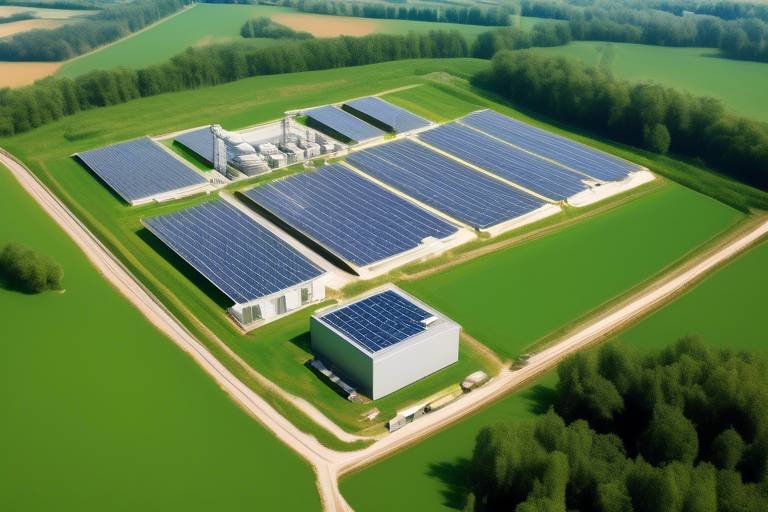How to Get Young People Interested in Green Energy
This article explores effective strategies to engage the younger generation in green energy initiatives, emphasizing education, innovation, and community involvement to foster a sustainable future.
Raising awareness about green energy through educational programs can ignite interest among young people. Tailored workshops and interactive sessions can enhance understanding and encourage active participation in sustainable practices. Imagine a classroom where students not only learn about solar panels but also get to build small models themselves. This hands-on approach not only makes learning fun but also instills a sense of responsibility towards the environment. By incorporating real-world applications into the curriculum, we can transform theoretical knowledge into practical skills that resonate with young minds.
Social media platforms are powerful tools for reaching young audiences. Creative campaigns showcasing the benefits of green energy can inspire and motivate them to advocate for sustainable solutions within their communities. Think about it: a catchy TikTok dance about recycling or an Instagram challenge to reduce plastic use can go viral and spark conversations. By leveraging platforms where young people spend their time, we can create a buzz around green energy that feels relatable and engaging. The key is to make sustainability not just a topic of discussion but a lifestyle choice that is celebrated and shared.
Integrating technology into green energy initiatives can capture the interest of tech-savvy youth. Innovative apps and platforms that promote sustainability can engage them in meaningful ways and encourage eco-friendly behaviors. For example, imagine an app that tracks your carbon footprint while rewarding you for using public transport or biking. By gamifying eco-friendly actions, we can turn sustainability into a fun challenge that young people want to participate in. This blend of technology and environmental stewardship can create a new generation of eco-conscious individuals who are excited about making a difference.
Involving young people in local green energy projects fosters a sense of ownership and responsibility. Community events and volunteer opportunities can inspire them to contribute actively to sustainable initiatives. Picture a community garden where young people not only plant trees but also learn about the importance of biodiversity and carbon sequestration. These experiences can create lasting memories and a deeper connection to their environment. When young individuals see the direct impact of their efforts, it cultivates a sense of pride and commitment to continuing their involvement in green initiatives.
Offering incentives for participation in green energy programs can motivate young individuals. Scholarships, contests, and recognition for their contributions can drive enthusiasm and commitment to sustainability efforts. For instance, a local organization might host a competition for the best green energy project proposal, with the winner receiving a scholarship or funding to bring their idea to life. This not only encourages creativity but also shows young people that their ideas can lead to tangible change. By celebrating their achievements, we can create a culture of innovation and enthusiasm around green energy.
Partnering with influencers who advocate for green energy can amplify messages and reach wider audiences. Young people often look up to these figures, making collaboration an effective strategy to spark interest. When a popular YouTuber shares their journey of switching to renewable energy or showcases eco-friendly products, it resonates deeply with their followers. This kind of authentic advocacy can inspire young people to take action in their own lives, turning passive interest into active participation. By leveraging the influence of these figures, we can create a powerful movement towards sustainability.
Providing hands-on experience through internships or workshops can deepen understanding and interest in green energy. Practical involvement allows young people to see the impact of their contributions firsthand. For example, internships at renewable energy companies or workshops on building solar panels can provide invaluable insights into the industry. These experiences not only enhance their resumes but also solidify their passion for green energy. When young people feel equipped with knowledge and skills, they are more likely to pursue careers in sustainability, driving innovation and change in the field.
Encouraging young innovators to develop green energy solutions can stimulate interest. Competitions and hackathons focused on sustainability can inspire creativity and drive the development of new ideas. Imagine a weekend event where teams collaborate to create the next big app for tracking energy consumption or design a prototype for a new type of wind turbine. These events can be a breeding ground for groundbreaking ideas and foster a spirit of collaboration among young minds. By providing a platform for innovation, we can empower the next generation to take charge of their future.
Showcasing the diverse career paths within the green energy sector can attract young talent. Informational sessions and mentorship programs can guide them toward fulfilling careers in sustainability. With the green energy sector booming, there are countless opportunities waiting to be explored. From engineering roles in solar technology to marketing positions for eco-friendly products, the possibilities are endless. By connecting young people with industry professionals, we can help them envision a future where they can thrive while making a positive impact on the planet.
- What are some simple ways to get started with green energy? You can start by reducing energy consumption, using energy-efficient appliances, and exploring renewable energy options like solar panels.
- How can I get involved in my community's green energy initiatives? Look for local organizations or events focused on sustainability, and consider volunteering or participating in workshops.
- Are there career opportunities in the green energy sector? Yes, the green energy sector offers a wide range of career paths, including engineering, research, policy-making, and marketing.
- How can social media help promote green energy? Social media can spread awareness and engage young people through creative campaigns and challenges that highlight the benefits of green energy.

Education and Awareness
Raising awareness about green energy is crucial in igniting interest among young people. Imagine a world where the sun powers our homes and the wind fuels our cars—this isn't just a dream; it's a reality waiting to happen! By implementing tailored workshops and interactive sessions in schools and community centers, we can enhance understanding and encourage active participation in sustainable practices. These educational programs should not only focus on the science behind green energy but also highlight its importance in combating climate change and building a sustainable future.
One effective approach is to incorporate hands-on activities that allow young people to engage directly with green technologies. For instance, workshops could include building solar-powered devices or conducting experiments related to renewable energy. This experiential learning makes the concept of green energy tangible and relatable. Additionally, including local environmental issues in the curriculum can help students connect the dots between their education and real-world applications. When young individuals see the direct impact of their learning on their community, they are more likely to become passionate advocates for sustainable solutions.
Moreover, collaboration with local organizations can amplify these educational efforts. Schools can partner with environmental groups to host events that not only educate but also inspire action. For example, a community clean-up day can be combined with informative sessions on how waste management ties into green energy initiatives. This blend of education and action fosters a sense of community and responsibility among participants.
To make these educational initiatives even more effective, we can leverage technology. Online platforms and social media can serve as powerful tools to disseminate information and engage young audiences. Imagine an interactive app where students can track their carbon footprint and learn ways to reduce it—this kind of innovative approach can captivate the tech-savvy youth of today. By making learning about green energy fun and accessible, we can cultivate a generation that is not only informed but also motivated to make a difference.
In conclusion, education and awareness are the cornerstones of engaging young people in green energy initiatives. By adopting creative teaching methods, collaborating with local organizations, and utilizing technology, we can inspire a new generation to take action for a sustainable future. After all, when young people are educated about the possibilities of green energy, they become the champions of change that our planet desperately needs.
Q: Why is it important to educate young people about green energy?
A: Educating young people about green energy is essential for fostering awareness of environmental issues and encouraging sustainable practices. They are the future leaders and decision-makers, and their understanding of these concepts will shape the future of our planet.
Q: How can technology enhance green energy education?
A: Technology can enhance green energy education by providing interactive learning experiences through apps, online courses, and virtual workshops. These tools make learning more engaging and accessible, especially for tech-savvy youth.
Q: What role do community organizations play in promoting green energy awareness?
A: Community organizations play a vital role in promoting green energy awareness by hosting events, providing resources, and facilitating partnerships between schools and local businesses. They help create a supportive environment for learning and action.

Utilizing Social Media
In today's digital age, social media stands as a powerful platform that can ignite interest in green energy among young people. With billions of users worldwide, platforms like Instagram, TikTok, and Twitter are not just for sharing memes or selfies; they are dynamic spaces where ideas can flourish and movements can gain momentum. Imagine a world where a simple post about renewable energy can reach thousands, if not millions, of young minds, sparking curiosity and action. This is the potential of social media, and harnessing it effectively can lead to a greener future.
To truly engage the youth, it's essential to create creative campaigns that resonate with their values and interests. For example, visually striking infographics that highlight the benefits of solar energy or videos showcasing local green initiatives can capture attention and encourage sharing. Young people love content that is not only informative but also entertaining. Think of it as a call to action wrapped in a fun package—like a viral dance challenge that promotes recycling or a hashtag campaign that encourages sustainable living.
Moreover, partnering with influencers who are passionate about environmental issues can amplify these messages. Influencers have a unique ability to connect with their audience on a personal level, making them ideal advocates for green energy. When a popular figure shares their commitment to sustainability, it can inspire their followers to take action as well. This creates a ripple effect, where the enthusiasm for green energy spreads like wildfire through social media feeds.
Engagement is not just about posting content; it's about fostering a community. Creating interactive spaces where young people can share their ideas, experiences, and solutions can cultivate a sense of belonging. For instance, hosting online challenges or contests that encourage users to showcase their eco-friendly projects can lead to a surge of creativity. Imagine a platform where young innovators can share their green inventions, receive feedback, and collaborate with others. This not only builds a network of like-minded individuals but also promotes a culture of sustainability.
In addition, leveraging user-generated content is a fantastic way to keep the momentum going. Encourage young people to share their stories about how they contribute to green energy initiatives—be it through personal projects, community involvement, or even small changes in their daily lives. By spotlighting these stories, you not only validate their efforts but also inspire others to follow suit. It’s like a chain reaction of positivity and action, all sparked by the power of social media.
Ultimately, utilizing social media for green energy advocacy is about creating a vibrant, engaging dialogue that resonates with young people. By crafting compelling content, collaborating with influencers, and fostering community engagement, we can turn the tide and inspire the next generation to embrace sustainable practices. So, let’s harness the power of social media and turn it into a catalyst for change—one post at a time!
- How can I get involved in green energy initiatives through social media? You can start by following organizations focused on sustainability, participating in online challenges, and sharing your own eco-friendly practices.
- Which social media platforms are best for engaging with young people about green energy? Platforms like Instagram, TikTok, and Twitter are particularly effective due to their visual and interactive nature.
- Can influencers really make a difference in promoting green energy? Absolutely! Influencers have the power to reach large audiences and can inspire their followers to take action toward sustainability.

Incorporating Technology
In today's fast-paced world, technology is not just a tool; it's a vital part of our lives, especially for the younger generation. When it comes to engaging young people in green energy, leveraging technology can create a powerful connection. Think about it: young people are digital natives, and they thrive in environments where technology is at the forefront. By incorporating innovative tech solutions into green energy initiatives, we can not only capture their attention but also inspire them to take action.
One of the most effective ways to harness technology is through the development of mobile applications that promote sustainability. Imagine an app that tracks your carbon footprint or rewards you for using public transport instead of driving. Such applications can gamify sustainable practices, making them fun and engaging. For example, users could earn points for biking to school or participating in local clean-up events, which they can later redeem for discounts at eco-friendly stores. This not only motivates young people but also instills a sense of responsibility towards the environment.
Moreover, virtual reality (VR) and augmented reality (AR) technologies can play a significant role in educating young individuals about green energy. By creating immersive experiences that showcase the impact of renewable energy sources, we can help them visualize a sustainable future. For instance, imagine a VR simulation that allows users to explore a solar farm or a wind turbine installation. This hands-on experience can deepen their understanding and spark their interest in pursuing careers in the green energy sector.
Equally important is the use of social media platforms to spread awareness and encourage participation in green energy initiatives. Young people are constantly connected online, and captivating content can go viral in a matter of hours. By creating shareable videos, infographics, and interactive posts that highlight the benefits of green energy, we can inspire them to advocate for sustainable solutions within their communities. Platforms like Instagram, TikTok, and Twitter can serve as powerful channels to disseminate information and engage young audiences in meaningful conversations about sustainability.
Furthermore, integrating technology into educational institutions can create a culture of innovation around green energy. Schools and universities can incorporate sustainability-focused curricula that utilize cutting-edge technologies. For example, students could work on projects that involve designing energy-efficient buildings or developing new renewable energy technologies. By providing access to tools like 3D printers, coding software, and renewable energy kits, educational institutions can empower young minds to think creatively and develop practical solutions to environmental challenges.
In conclusion, incorporating technology into green energy initiatives is not just about attracting young people; it's about creating a movement. By leveraging apps, VR experiences, social media, and innovative educational tools, we can inspire the next generation to embrace sustainability and become active participants in the green energy revolution. The future of our planet depends on their engagement, and technology is the key to unlocking their potential.
- How can technology help in promoting green energy?
Technology can create interactive experiences, gamify sustainable practices, and facilitate education about renewable energy sources. - What role do social media platforms play in engaging young people?
Social media allows for the sharing of compelling content that can inspire advocacy and community involvement in green energy initiatives. - Are there specific apps designed for promoting sustainability?
Yes, many apps track carbon footprints, reward eco-friendly behaviors, and provide information on sustainable practices.

Community Engagement
When it comes to inspiring young people to get involved with green energy, plays a pivotal role. Imagine a vibrant neighborhood where everyone is working together to create a sustainable future. Sounds appealing, right? By actively involving young individuals in local green energy projects, we not only foster a sense of ownership but also spark a passion for sustainability that can last a lifetime. Community events, workshops, and volunteer opportunities can serve as the perfect platform for young people to dive into eco-friendly initiatives.
One of the most effective ways to engage youth is through hands-on projects. For example, organizing community clean-up days or tree-planting events can create a tangible connection to the environment. These activities not only promote green practices but also allow young people to see the immediate impact of their efforts. When they witness the transformation of their local area, it ignites a sense of pride and responsibility. Furthermore, collaboration with local schools and universities can amplify these efforts. Imagine students working side by side with community leaders to design and implement renewable energy solutions!
To make community engagement even more appealing, consider integrating fun and interactive elements. For instance, hosting competitions where teams can develop their own green energy projects can foster a spirit of innovation. You could even set up a
| Project Name | Description | Impact |
|---|---|---|
| Solar Power Initiative | Installing solar panels on community buildings | Reduced energy costs and carbon footprint |
| Community Garden | A sustainable garden that uses recycled water | Improved local biodiversity and access to fresh produce |
| Eco-Friendly Festival | A celebration featuring local green businesses | Increased awareness and support for sustainable practices |
Moreover, creating a youth advisory board can ensure that young voices are heard in community decisions related to green energy. This board can provide insights on what initiatives resonate most with their peers, making programs more effective and relevant. By empowering youth to take the lead, we not only enhance their engagement but also cultivate future leaders in sustainability.
Ultimately, the key to successful community engagement lies in building relationships. When young people feel connected to their community and see their contributions making a difference, they are more likely to remain committed to green energy initiatives. So, let’s roll up our sleeves and get involved! Together, we can create a sustainable future that inspires the next generation.
- Why is community engagement important for green energy?
Community engagement fosters a sense of ownership and responsibility among young people, encouraging them to actively participate in sustainable initiatives. - How can I get involved in local green energy projects?
Look for community events, volunteer opportunities, or local organizations focused on sustainability. Joining or forming a youth advisory board can also be a great way to contribute. - What types of projects can young people participate in?
Young people can engage in various projects, such as tree planting, community gardens, and renewable energy installations, which all contribute to a greener future.

Incentives and Rewards
When it comes to engaging young people in green energy initiatives, play a crucial role. Imagine being part of a movement that not only helps the planet but also offers you tangible benefits. By providing incentives, we can spark interest and motivate young individuals to dive into sustainable practices. Think about it: who wouldn’t want to earn something while making a positive impact?
There are various ways to implement incentives that resonate with the younger generation. For instance, scholarships for environmental studies can encourage students to pursue careers in green energy. Contests that reward innovative ideas for sustainability can stimulate creativity and a competitive spirit. Recognition programs, where young contributors are publicly acknowledged for their efforts, can foster a sense of pride and belonging. Here’s a quick look at some effective incentives:
- Scholarships: Financial support for students pursuing degrees in environmental science or related fields.
- Contests: Competitions that challenge participants to come up with innovative green energy solutions, with prizes for the best ideas.
- Recognition Programs: Events or platforms that highlight young individuals’ contributions to sustainability.
Moreover, the excitement of gamification can also be a fantastic way to engage young people. Implementing a point system where they earn points for participating in green initiatives can create a fun and competitive environment. These points could be redeemed for rewards such as discounts at eco-friendly stores, exclusive merchandise, or even tickets to environmental conferences.
To further illustrate the potential of these incentives, consider a local community that organizes a green energy fair. By offering prizes for the most innovative booth or the best presentation on sustainability, they not only encourage participation but also educate the attendees. This creates an atmosphere where young people feel valued and motivated to contribute.
In essence, the right incentives can transform passive interest into active engagement. When young individuals see that their efforts are recognized and rewarded, they are more likely to commit to long-term involvement in green energy initiatives. The key is to create a system that not only inspires but also makes them feel like they are part of something bigger—a movement towards a sustainable future.
Q: What types of incentives are most effective for young people?
A: Scholarships, competitions, and recognition programs tend to resonate well with young individuals, as they provide both financial benefits and a sense of accomplishment.
Q: How can gamification be integrated into green energy initiatives?
A: By creating a point system where participants earn rewards for their contributions, such as discounts or exclusive merchandise, gamification can make engagement more fun and competitive.
Q: Why is community involvement important in promoting green energy?
A: Community engagement fosters a sense of ownership and responsibility among young people, encouraging them to actively contribute to sustainable initiatives and feel connected to their local environment.

Collaboration with Influencers
This article explores effective strategies to engage the younger generation in green energy initiatives, emphasizing education, innovation, and community involvement to foster a sustainable future.
Raising awareness about green energy through educational programs can ignite interest among young people. Tailored workshops and interactive sessions can enhance understanding and encourage active participation in sustainable practices.
Social media platforms are powerful tools for reaching young audiences. Creative campaigns showcasing the benefits of green energy can inspire and motivate them to advocate for sustainable solutions within their communities.
Integrating technology into green energy initiatives can capture the interest of tech-savvy youth. Innovative apps and platforms that promote sustainability can engage them in meaningful ways and encourage eco-friendly behaviors.
Involving young people in local green energy projects fosters a sense of ownership and responsibility. Community events and volunteer opportunities can inspire them to contribute actively to sustainable initiatives.
Offering incentives for participation in green energy programs can motivate young individuals. Scholarships, contests, and recognition for their contributions can drive enthusiasm and commitment to sustainability efforts.
Partnering with influencers who advocate for green energy can amplify messages and reach wider audiences. Young people often look up to these figures, making collaboration an effective strategy to spark interest. Think about it: when a popular influencer shares a post about renewable energy or sustainable living, it can create a ripple effect. Their followers, many of whom are young individuals, are likely to engage with the content, share it, and even take action. This is where the magic happens!
To maximize the impact of these collaborations, it's essential to choose influencers who genuinely resonate with the values of sustainability. Authenticity is key; young audiences can easily spot insincerity. When influencers are passionate about green energy, their enthusiasm becomes contagious. They can share personal stories about how they incorporate sustainability into their daily lives, making the message relatable and compelling.
Moreover, influencers can host challenges or campaigns that encourage their followers to participate in green initiatives. For instance, a social media challenge that invites followers to share their eco-friendly habits can create a sense of community and friendly competition. This not only raises awareness but also fosters a collective effort towards sustainability.
In addition, collaborating with influencers can lead to innovative content creation. Whether it's through engaging videos, informative blog posts, or eye-catching graphics, the creative possibilities are endless. By leveraging their unique styles, influencers can present green energy topics in a way that captivates and informs their audience.
Ultimately, the collaboration between green energy advocates and influencers can be a powerful tool in shaping the attitudes and behaviors of young people. It's about creating a movement, a buzz that encourages them to think about their energy choices and the impact they have on the planet. So, let’s harness the power of influence to spark a greener future!
Providing hands-on experience through internships or workshops can deepen understanding and interest in green energy. Practical involvement allows young people to see the impact of their contributions firsthand.
Encouraging young innovators to develop green energy solutions can stimulate interest. Competitions and hackathons focused on sustainability can inspire creativity and drive the development of new ideas.
Showcasing the diverse career paths within the green energy sector can attract young talent. Informational sessions and mentorship programs can guide them toward fulfilling careers in sustainability.
- What are some effective ways to engage young people in green energy?
Effective ways include educational programs, social media campaigns, and hands-on projects. - How can influencers help promote green energy?
Influencers can reach large audiences and create relatable content that inspires action towards sustainability. - Why is community involvement important in green energy initiatives?
Community involvement fosters a sense of ownership and encourages active participation in sustainable practices. - What incentives can motivate young people to participate in green energy?
Incentives such as scholarships, contests, and public recognition can drive enthusiasm for sustainability efforts.

Hands-On Experience
This article explores effective strategies to engage the younger generation in green energy initiatives, emphasizing education, innovation, and community involvement to foster a sustainable future.
Raising awareness about green energy through educational programs can ignite interest among young people. Tailored workshops and interactive sessions can enhance understanding and encourage active participation in sustainable practices.
Social media platforms are powerful tools for reaching young audiences. Creative campaigns showcasing the benefits of green energy can inspire and motivate them to advocate for sustainable solutions within their communities.
Integrating technology into green energy initiatives can capture the interest of tech-savvy youth. Innovative apps and platforms that promote sustainability can engage them in meaningful ways and encourage eco-friendly behaviors.
Involving young people in local green energy projects fosters a sense of ownership and responsibility. Community events and volunteer opportunities can inspire them to contribute actively to sustainable initiatives.
Offering incentives for participation in green energy programs can motivate young individuals. Scholarships, contests, and recognition for their contributions can drive enthusiasm and commitment to sustainability efforts.
Partnering with influencers who advocate for green energy can amplify messages and reach wider audiences. Young people often look up to these figures, making collaboration an effective strategy to spark interest.
Providing through internships or workshops can deepen understanding and interest in green energy. Imagine a young person working directly with solar panels, feeling the sun's energy transform into electricity right before their eyes. This tangible experience not only solidifies their learning but also ignites a passion for sustainable practices. Programs that offer practical involvement allow young people to witness the impact of their contributions firsthand, making the concept of green energy more relatable and exciting.
Moreover, organizations can partner with educational institutions to create real-world projects where students can apply their knowledge. For instance, students could work on local community solar projects, participating in every step from planning to execution. Such projects are not merely educational; they also provide a sense of accomplishment and purpose.
To further enhance these experiences, workshops could include:
- Building small-scale wind turbines
- Installing solar panels on community buildings
- Participating in energy audits for local businesses
By engaging in these activities, young individuals can develop a practical skill set that is highly relevant in today’s job market. They can also network with professionals in the field, opening doors to future career opportunities. When young people see how their efforts contribute to a larger goal—like reducing carbon footprints—they are more likely to stay committed to sustainability.
Encouraging young innovators to develop green energy solutions can stimulate interest. Competitions and hackathons focused on sustainability can inspire creativity and drive the development of new ideas.
Showcasing the diverse career paths within the green energy sector can attract young talent. Informational sessions and mentorship programs can guide them toward fulfilling careers in sustainability.
Q: How can I get involved in green energy initiatives?
A: You can start by participating in local community projects, internships, or workshops focused on sustainability. Many organizations offer programs that welcome young volunteers.
Q: What are some examples of hands-on experiences in green energy?
A: Examples include building solar panels, conducting energy audits, and participating in community recycling programs. These activities provide practical skills and knowledge.
Q: Are there scholarships available for students interested in green energy?
A: Yes, many organizations offer scholarships for students pursuing studies in environmental science, renewable energy, and related fields. Check with your educational institution or local environmental groups for opportunities.
Q: How can social media help promote green energy?
A: Social media platforms allow for creative campaigns that can spread awareness and inspire action among young people. They can share their experiences and advocate for sustainable practices within their networks.

Promoting Innovation
In today's fast-paced world, innovation is the key to unlocking the potential of green energy. Encouraging young innovators to develop sustainable solutions is not just a trend; it's a necessity for a healthier planet. Think about it—every groundbreaking idea starts with a spark of creativity. By fostering an environment where young minds can explore and experiment, we can stimulate interest in green energy and drive meaningful change.
One effective way to promote innovation is through competitions and hackathons that focus on sustainability. These events not only challenge participants to think outside the box but also provide them with the opportunity to collaborate with like-minded peers. Imagine a room filled with enthusiastic young people, all brainstorming ways to harness solar energy more efficiently or create biodegradable materials. The energy in such an atmosphere is palpable!
Moreover, educational institutions can play a vital role in this process. By integrating green energy concepts into their curriculums, schools and universities can inspire students to pursue projects that contribute to sustainability. This can include everything from engineering challenges to business plans aimed at reducing carbon footprints. When students see their ideas come to life, it boosts their confidence and motivates them to continue exploring innovative solutions.
Another avenue for promoting innovation is through partnerships with local businesses and organizations. By connecting young innovators with industry professionals, we create a bridge between education and real-world application. These collaborations can lead to mentorship opportunities, internships, and even funding for promising projects. Young people thrive when they can see the impact of their work, and having access to experienced mentors can provide invaluable guidance.
To illustrate the potential of youth-led innovation in green energy, consider the following table showcasing successful projects developed by young innovators:
| Project Name | Description | Impact |
|---|---|---|
| Solar-Powered Water Purifier | A portable device that uses solar energy to purify drinking water. | Improves access to clean water in remote areas. |
| Eco-Friendly Packaging | Biodegradable packaging made from plant-based materials. | Reduces plastic waste in landfills. |
| Smart Energy Management System | An app that optimizes energy consumption in homes. | Helps families save on energy bills while reducing their carbon footprint. |
These examples highlight how young minds can lead the charge in green energy innovation. By providing the right resources, support, and opportunities, we can empower the next generation to think creatively about sustainability. The future is bright when we invest in the ideas of our youth, and who knows? The next big breakthrough in green energy could come from a young innovator just waiting for their chance to shine!
- How can I get involved in promoting green energy innovation?
There are many ways to get involved, including participating in local competitions, joining sustainability clubs at school, or volunteering with organizations focused on green initiatives. - What skills do I need to innovate in green energy?
While technical skills in areas like engineering or science can be beneficial, creativity, problem-solving, and a passion for sustainability are equally important. - Are there funding opportunities for young innovators?
Yes! Many organizations offer grants, scholarships, and competitions with cash prizes specifically aimed at young innovators in the green energy sector.

Highlighting Career Opportunities
When it comes to engaging young people in the realm of green energy, one of the most effective strategies is to highlight the diverse career opportunities available in this booming sector. The green energy industry is not just about solar panels and wind turbines; it encompasses a wide range of professions that cater to various interests and skill sets. From engineering to marketing, and research to project management, there is a place for everyone in this field. Imagine waking up each day knowing that your work contributes to a healthier planet; how inspiring is that?
By showcasing the variety of roles within the green energy sector, we can ignite a passion in young individuals to pursue careers that not only fulfill their personal ambitions but also promote sustainability. For instance, consider the following career paths:
- Renewable Energy Engineer: These professionals design and develop systems that harness renewable energy sources.
- Environmental Scientist: They study the environment and work on projects that aim to protect it.
- Energy Analyst: This role involves analyzing data to improve energy efficiency and sustainability.
- Project Manager: Overseeing green energy projects from conception to completion, ensuring they meet sustainability goals.
- Marketing Specialist: Promoting green energy products and initiatives to raise awareness and drive consumer interest.
Moreover, educational institutions are increasingly recognizing the importance of sustainability, and many are offering specialized programs and degrees in renewable energy and environmental science. This trend not only prepares students for the job market but also equips them with the knowledge and skills necessary to tackle pressing environmental challenges. Schools and universities can also play a pivotal role by collaborating with industry professionals to create internship programs, which provide students with hands-on experience and a clearer understanding of career options in the green energy sector.
Furthermore, mentorship programs can be incredibly beneficial. By connecting young people with experienced professionals, we can provide guidance and support that encourages them to explore career opportunities in green energy. These relationships can help demystify the industry, allowing students to ask questions, seek advice, and ultimately feel more confident about pursuing a career in sustainability.
In conclusion, as we continue to advocate for a greener future, it’s crucial to not only inform young people about the environmental benefits of renewable energy but also to highlight the exciting career opportunities that await them. By painting a vivid picture of what a career in green energy looks like and the impact it can have, we can inspire the next generation of environmental leaders. After all, who wouldn’t want a job that contributes to a sustainable future?
Q1: What types of jobs are available in the green energy sector?
A1: The green energy sector offers a variety of jobs including renewable energy engineers, environmental scientists, energy analysts, project managers, and marketing specialists.
Q2: How can I start a career in green energy?
A2: You can start by pursuing relevant educational programs, seeking internships, and networking with professionals in the field.
Q3: Are there mentorship programs available for young people interested in green energy?
A3: Yes, many organizations and educational institutions offer mentorship programs to connect students with industry professionals.
Q4: What skills are important for a career in green energy?
A4: Important skills include analytical thinking, problem-solving, communication, and a strong foundation in science and technology.
Frequently Asked Questions
- Why is it important to engage young people in green energy initiatives?
Engaging young people in green energy initiatives is crucial because they are the future leaders and decision-makers. By fostering their interest in sustainability, we can ensure that they carry forward the torch of environmental responsibility, leading to innovative solutions and a greener planet.
- How can education play a role in promoting green energy among youth?
Education is a powerful tool that can spark curiosity and understanding about green energy. Tailored workshops, interactive sessions, and hands-on learning experiences can make complex concepts accessible and exciting, encouraging young people to actively participate in sustainable practices.
- What role does social media play in raising awareness about green energy?
Social media acts as a megaphone for green energy messages, allowing creative campaigns to reach a broad audience quickly. By leveraging platforms that young people frequent, we can inspire them to advocate for sustainable solutions and engage in community discussions about environmental issues.
- How can technology attract young people to green energy?
Integrating technology into green energy initiatives can capture the attention of tech-savvy youth. Innovative apps, online platforms, and interactive tools can make sustainability engaging and relatable, encouraging them to adopt eco-friendly behaviors in their daily lives.
- What are some effective ways to involve youth in community green energy projects?
Involving young people in local green energy projects can foster a sense of ownership. Organizing community events, volunteer opportunities, and collaborative projects can inspire them to contribute actively, making them feel like valuable participants in the sustainability movement.
- Are there incentives for young people to participate in green energy programs?
Yes! Offering incentives such as scholarships, contests, and public recognition can motivate young individuals to engage in green energy initiatives. These rewards not only drive enthusiasm but also create a culture of appreciation for their contributions to sustainability.
- How can influencers help promote green energy among young people?
Collaborating with influencers who are passionate about green energy can amplify messages and reach wider audiences. Young people often look up to these figures, making it an effective strategy to spark interest and inspire action toward sustainability.
- What kind of hands-on experiences can deepen young people's interest in green energy?
Providing hands-on experiences, such as internships, workshops, and real-world projects, allows young people to see the impact of their contributions firsthand. This practical involvement can enhance their understanding and ignite a passion for green energy solutions.
- How can young innovators contribute to green energy solutions?
Encouraging young innovators to develop green energy solutions can stimulate interest and creativity. Organizing competitions and hackathons focused on sustainability can inspire them to think outside the box and drive the development of innovative ideas.
- What career opportunities are available in the green energy sector?
The green energy sector offers diverse career paths, ranging from engineering and research to policy-making and entrepreneurship. Informational sessions, mentorship programs, and networking opportunities can guide young people toward fulfilling careers in sustainability.



















